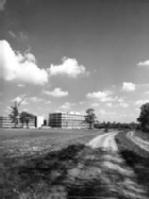Introducing the Exhibition
You get students and researchers; maybe it’s a bit optimistic to hope that researchers and students will keep bumping into one another and wonderful things will happen.
MJP Architects, Interview 2010
The Idea of a University maps the spatial generation and development of the University of Warwick from the 1960s to the present day. Drawing on archival and interview research data, the exhibition opens up a space for thinking about how ideas and ideals about the University have shaped, and continue to shape, the geographical, cultural, political and intellectual landscapes of its border location on the outskirts of Coventry. The materials suggest the significance of the built environment to different aspects of the university. These include: students, staff, and the relations between them; the production and organisation of knowledge(s); the ways in which identities, feelings and actions are shaped through and by the landscape; and the impact on the local and wider communities when the big white buildings of Coventry’s first university appeared on the Warwickshire countryside, described by Mike Shattock as being ‘like a spaceship landing’.
Geographers Duncan Fuller and Kye Askins ask of academics, ‘Why not stop writing whenever possible for a while and be more imaginative with your output/activity/engagement in publics?’ (2007: 21). In response, The Idea of a University has been researched and curated by a collaborative team of student and staff researchers from The Reinvention Centre. This exhibition provides a glimpse at the data. In keeping with the research as a whole, it does not provide any simple answers, but aims to capture some of the complexities of educational space and spatialised practices. The stories the exhibit tells sometimes appear to present ‘conflicting’ accounts. Less interested in seeking ‘truth’, the material here points to the generative role of disagreement in constituting and reinventing the space of the University.
Cath Lambert, Hannah Lever, Laura Evans, Laura Moorhouse, Danny Wilding

